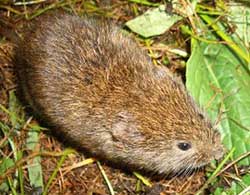A new scientific study predicts that some of Alaska’s mammal species will respond to future climate warming by concentrating in northern areas such as the Arctic National Wildlife Refuge and the National Petroleum Reserve of Alaska. If true, for many species, this would be a significant northward shift into tundra habitats where they are currently absent.
“Small mammal species such as shrews and voles, and larger species like wolverine and marmots have been in Alaska for many thousands of years and have responded to past climate cycles just as they are responding to the current warming trend,” said Dr. Andrew Hope, lead author of the study and former researcher with the U.S. Geological Survey.
“Since these mammals experienced past climate cycles, we were able to interpret signatures of population level responses to those climate events recorded in their DNA, and then also use that information to predict likely shifts in animal distributions throughout Alaska into the future,” said Hope.
Researchers that participated in the study with Hope examined at total of 28 mammal species including those from both northern tundra and relatively more southern boreal forest habitats. The scientists determined the northern movement by looking at current geographic distribution of the animals, coupled with their historical range, and then interpreted from genetic signatures of response to past climate changes to predict where they will likely be found in 2050 and 2080.
Hope worked on the project with researchers from the USGS, the U.S. Fish and Wildlife Service’s Arctic National Wildlife Refuge, the City College of New York, the University of Nevada-Reno, and the University of New Mexico. The study leveraged genetic data collected over the past several decades in multiple laboratories.
“This approach allowed us to examine the consistency among predicted changes to mammal distributions and determine if there are differences in management implications across regions,” said David Payer, chair of the Arctic Landscape Conservation Cooperative and a co-author of the study.
This study highlights the value of analyzing many species associated with discrete ecological communities that each share different evolutionary histories.
Hope conducted the research as a post-doctoral fellow at the USGS.
The study was published in the Ecological Society of America’s journal Ecosphere.
Visit the USGS Alaska Science Center for more information.

